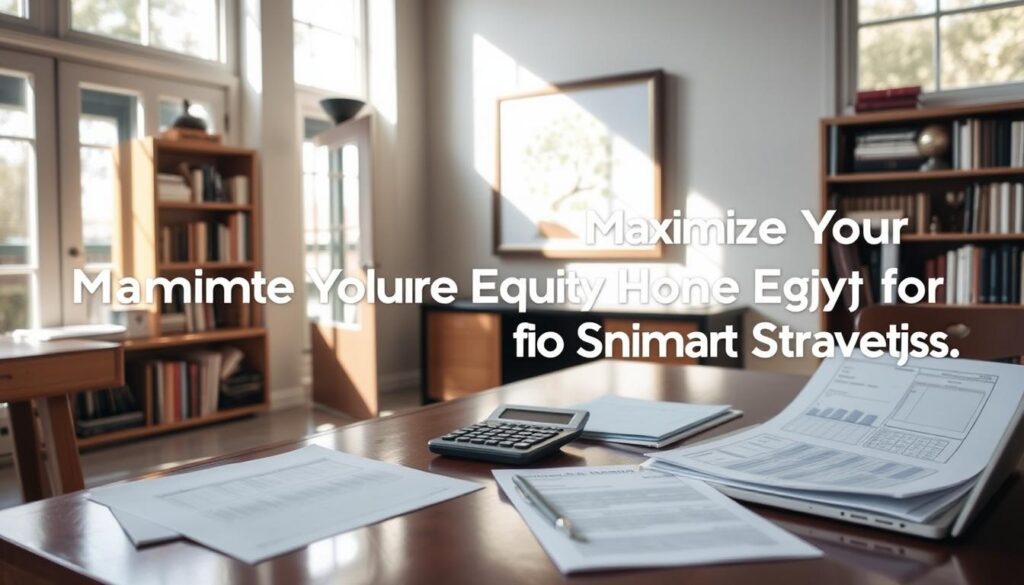Did you know the average U.S. homeowner holds over $250,000 in untapped home equity? That’s money locked in your property, waiting to be leveraged for life’s big goals—from renovations to education or even starting a business. This guide unlocks how to access that value without adding monthly debt burdens.
This article breaks down investing in home equity through options like HELOCs, cash-out refinance, or new investment vehicles. You’ll learn to calculate your equity, compare loan terms, and avoid common pitfalls. Whether boosting your finances or funding dreams, this guide simplifies turning your home’s value into actionable opportunities.
Understanding Home Equity
Home equity represents the portion of your home’s value that you truly own. The Definition and Basics of Home Equity start with this simple formula: Equity = Home Value minus Remaining Mortgage Balance. Over time, as you pay off your loan and home values rise, your equity grows.
- Every mortgage payment reduces debt, boosting your ownership share.
- Rising housing markets increase your home’s worth, directly adding to equity.
- Lenders track this number to determine borrowing limits for loans or lines of credit.
| Home Value | Mortgage Balance | Your Equity |
|---|---|---|
| $300,000 | $150,000 | $150,000 |
| Total Equity | % of Home Owned | Potential Borrowing Power |
| $200,000 | 67% | Up to 85% of equity* |
*Varies by lender terms.
Why does this matter for your finances? Equity isn’t just a number on paper—it’s accessible wealth. It lets you:
- Tap funds for home improvements without high-interest debt.
- Refinance to lower monthly payments.
- Retire debt through cash-out options.
Building equity strategically turns your home into a financial tool. Understanding these Basics of Home Equity empowers you to plan for major expenses or retirement with greater confidence.
Evaluating Your Home’s Market Value
To access your home equity effectively, you must first determine its market value. This number reflects what buyers are willing to pay today, shaping the equity you can tap into. Start by requesting a professional appraisal—a certified expert compares your home to recent sales of similar properties in your area.
- Appraisal accuracy: Appraisers analyze layout, age, upgrades, and neighborhood quality to calculate your home’s worth.
- Location impact: Schools, crime rates, and nearby amenities heavily influence market value.
- Trend analysis: Track local housing data to see if values are rising, falling, or stable over time.
Online tools like Zillow or Redfin offer estimates, but they’re no substitute for a professional’s insights. Monitor trends monthly to adjust your strategy. For instance, a booming local job market might boost your home’s market value faster than expected. Use this data to plan loans, renovations, or long-term investment moves confidently.
Regular checks help you spot opportunities. If values rise, your equity grows—making it easier to secure better loan terms or reinvest profits. Always consult a realtor or appraiser before making decisions. Your home’s value isn’t static; it’s a living number shaped by both your choices and the broader real estate landscape.
The Ultimate Guide to Home Equity Investment
Investment Fundamentals for home equity start with understanding how these options differ from traditional loans. Unlike mortgages or personal loans, home equity investments let you tap into your property’s value without monthly payments. For example, qualifying requires a credit score of 500+, and homes valued at least $250k with 30% equity can unlock up to $500k. Learn more about how these terms shape your strategy.
Decide between long-term or short-term approaches. Short-term plans might suit urgent needs, offering quick cash with lump-sum repayment at sale. Long-term options let you delay payback, sharing future appreciation gains. Both paths require weighing origination fees (3.9–5%) against flexibility.
- Short-term focus: Get cash now, repay when selling
- Long-term focus: Grow equity over 30 years, no monthly costs
Investment Fundamentals also mean considering risks. No income checks mean eligibility hinges on your home’s value and equity. Compare repayment terms: lump-sum at term end vs. selling the home. This structure offers freedom but demands careful planning to avoid overcommitting.
Ask yourself: Do you need funds immediately, or can you wait for appreciation gains? Balancing these choices helps align your decision with your financial goals.
Steps to Leverage Your Home’s Equity
Ready to turn your home’s value into accessible funds? Here’s how to start:
- Check your equity by subtracting your remaining mortgage balance from your home’s current market value. This shows how much you can borrow.
- Prequalify with lenders to get an estimate of loan amounts and rates. This step often requires credit score checks and income verification.
- Choose between a HELOC or cash-out refinance. A HELOC acts like a credit line you can reuse, while refinancing replaces your existing mortgage for a lump sum.
- Arrange an appraisal to confirm your home’s value. Lenders use this to finalize loan terms.
- Apply formally by submitting documents like tax returns and bank statements. Compare offers to pick the best terms.
- Review closing costs, interest rates, and repayment terms before signing. Ensure you understand fees tied to HELOC draws and payments.
- Close the loan to access funds. Funds can be used for renovations, education, or debt consolidation.
Remember, using a HELOC wisely means tracking interest-only periods and avoiding overextension. Always compare options to align with your financial goals.
Financial Planning for Home Equity Investment
Effective Budgeting for Investment ensures your home equity strategy aligns with long-term goals. Start by reviewing monthly cash flow and debt obligations to avoid overextending. Tax implications vary based on how funds are used—like home improvements versus personal expenses—so clarity here shapes your plan.
- Calculate your net income minus essential expenses to determine available funds for equity-related investments.
- Compare loan options: Home Equity Lines of Credit (HELOCs) vs. cash-out refinances, noting their fee structures and tax eligibility.
- Factor in property tax deductions and mortgage interest write-offs where applicable, per IRS guidelines.
Track Budgeting for Investment progress by listing projected returns against upfront costs. For instance, home renovations often boost resale value, but compare this gain to renovation expenses. Tax professionals can clarify deductions tied to property improvements.
- Emergency savings: Keep 3-6 months’ expenses untouched to avoid equity liquidation during crises.
- Fee comparisons: Lenders like Chase or Bank of America offer HELOCs with differing annual fees—research these details.
Aligning tax benefits with Budgeting for Investment decisions sharpens your strategy. Regularly reassess plans as market rates or personal finances shift.
Overcoming Common Home Equity Investment Challenges
Home equity investments can face challenges like market shifts or financial surprises. With the right Risk Management Tips, you can turn obstacles into manageable steps. Here’s how to stay steady during uncertain times:

- Track economic trends to spot changes early.
- Keep a reserve fund for emergencies.
- Work with advisors who specialize in equity strategies.
| Risk | Risk Management Strategy |
|---|---|
| Falling property values | Spread investments across assets |
| Rising interest rates | Lock in fixed-rate loans |
| Unexpected repairs | Set aside 5-10% of equity for maintenance |
Market volatility doesn’t have to derail your plans. Using these Risk Management Tips ensures you’re ready for anything life throws at your investment.
Case Studies and Success Stories
Let’s look at real stories of homeowners who turned equity into opportunities.
Take the Johnsons, who used a home equity line of credit (HELOC) to renovate their kitchen and bathroom. Their $25,000 investment added $40,000 to their home’s value. By choosing budget-friendly upgrades, they boosted their equity without overextending.
Another example: Maria, a small business owner, borrowed $50,000 against her home to expand her café. Within two years, profits rose 30%, proving equity can fuel career dreams. She emphasized researching lenders and market trends to avoid over-leveraging.
Key lessons from these real estate journeys include:
- Prioritizing projects that align with real estate trends
- Staying within 80% loan-to-value ratios
- Consulting financial advisors before borrowing
Even when challenges arose—like unexpected renovation costs—the families adapted. The Johnsons scaled back luxury fixtures, focusing on resale appeal. Maria kept emergency funds to cover delays. These adjustments highlight resilience in real estate ventures.
These stories show equity isn’t just a number. It’s a tool for growth when paired with smart planning and market awareness. Learning from others’ paths can guide your own strategy.
Expert Tips for Maximizing Returns
Insider Advice from Industry Experts emphasizes strategic moves to grow your equity wealth. Top firms like Point and Hometap share actionable steps to avoid pitfalls and seize opportunities. Here’s their roadmap for success:
- Compare cash-out refinance options with home equity loans. Use online calculators to weigh interest rates and repayment timelines.
- Track property trends via platforms like Zillow or Hometap’s market dashboards to time investments with rising valuations.
- Consult lender guides from Point for fee structures and tax implications before finalizing deals.
Experts stress the value of cash-out refinance for large-scale projects but advise against over-leveraging. Tools like Hometap’s debt-to-income ratio analyzers help assess affordability. Monitor local real estate cycles to sell or refinance at peak moments.
Insider Advice from Industry Experts also highlights the importance of diversifying equity use. Allocate funds wisely—prioritize home improvements that boost resale value over short-term gains. Regularly update your financial plan with lender consultations to adjust strategies as markets shift.
Conclusion
Exploring home equity investment strategies opens doors to financial flexibility without adding debt. Whether you’re tapping into equity for renovations, debt consolidation, or long-term goals, this approach avoids monthly payments and interest, as detailed in guides like this comprehensive resource. Remember, a 25% equity minimum and clear plans for repayment—like sharing future appreciation—form the foundation of these deals.
Compare options like HELOCs or reverse mortgages if you’re 62+, but prioritize strategies that align with your financial goals. Work with trusted advisors to balance risk and reward. By focusing on smart choices, you can turn your home’s value into opportunities without straining your budget. Your next steps depend on your unique situation, but the insights here provide a roadmap to build confidence in managing your equity wisely.



